
Jump to:
Gobo is a root vegetable largely unfamiliar to people in Western countries. In fact, even if you give the official translation of “Burdock root”, there is a high chance that this, in itself, will not ring any bells either. However, its somewhat addictive crunchy texture and sweet, earthy taste, added to its culinary versatility and health benefits mean that it's certainly something worth making an effort to get to know.
In this article, we shall discuss what Gobo is, including its appearance, taste, and different types, the history of its use in Japan, and its health benefits. We shall also look at some of the wide range of dishes in which you can find Gobo, tips for choosing and storing it, and round off by looking at options for purchasing and enjoying Gobo.
What Is Gobo?
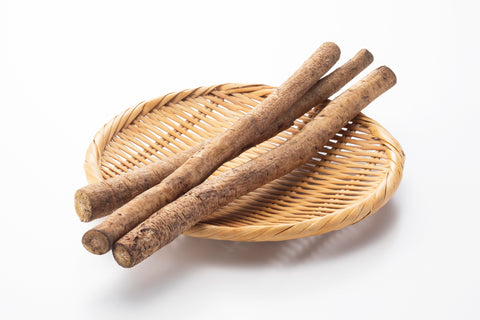
Gobo is one of the many great Japanese root vegetables (see this article for an introduction to Japanese vegetables). It is a long and slender perennial plant, which grows up to three feet (or just under 1 meter). Resembling a tree root, Gobo often has mud on it when you pick it up at the greengrocer's, and when scrubbed clean it looks similar to a brown carrot, with its rusty beige color. Although it has quite a unique taste, some people have compared its sweet, earthy flavor to that of artichoke.
Gobo tends to store well and so is shipped throughout the year. However, it can be said to be in season from late fall to early winter, so this is the time to get the Gobo with the richest flavor.
In Japan, food that is long tends to be associated with good fortune and is eaten around the New Year holiday. Gobo has long thin roots that go deep in the ground and this, in addition to the fact that it keeps relatively well, is a reason for its widespread use in New Year Osechi food.
Types Of Gobo
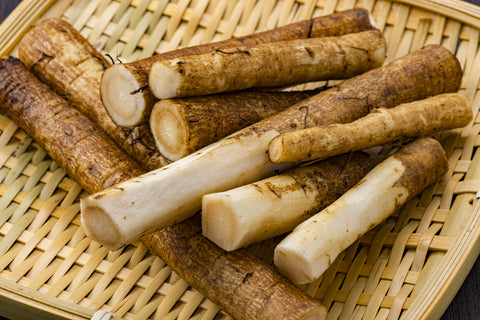
Although you may have only come across one type of Gobo, there are actually various types that have different characteristics depending on where they are produced. In the Kanto region, where the soil is deep and well-drained, the long-rooted type, represented by Takinogawa burdock, is the most common type. In the shallower soil of the Kansai region, a type with shorter roots and white-stemmed white flower group (leaf burdock), which has edible young roots, has been developed. In addition, there are other branded types of burdock in various regions of Japan, such as "Oura burdock," which is cultivated only in Chiba Prefecture, and "Horikawa burdock" from Kyoto. The Takinogawa type is the mainstream one, however, and this is what most people are referring to when they talk of Gobo.
How Long Has Gobo Been Eaten In Japan?
Said to have originated from the Northern part of Eurasia, the relationship between Gobo and Japanese people stretches far back into history. Now, it is enjoyed as a regular root vegetable, but did you know that when it first was introduced to Japan from China at the start of the Heian period (794-1185), it was done so not as a food, but as a medicinal herb said to have detoxifying, antifebrile (brings down fevers), and antitussive (cough suppressant) benefits? It was not until the mid-to late-Heian period that people began to use it in their food. With the improvement of agricultural practices in the Edo period (1603-1868), a greater quantity and variety of Gobo was produced, and this stimulated its widespread adoption, leading us to the present age where it is now a staple of the Japanese diet.
Is Gobo Good For Your Health?

There is something distinctly Japanese about Gobo. Many foreigners are surprised when they first discover that Japanese people eat tree roots, but they are even more surprised when they find out all of the potential health benefits.
Gobo is not vitamin-rich but it has a significant amount of fiber and minerals. Antioxidants help protect cells in the body from damage by free radicals and are thought to help treat and prevent a wide range of different health conditions. They can also reduce inflammation, which has benefits for skin issues such as acne and eczema. Gobo contains multiple types of powerful antioxidants, including quercetin, luteolin, and phenolic acids.
As mentioned before, Gobo has long been considered to have detoxifying benefits and modern science seems to back this up, with studies showing that it helps removes toxins from the blood and activates the functionality of the kidneys as a diuretic.
There have been some suggestions as well that it may serve as an aphrodisiac but expectations on this front should be tempered by the fact that studies so far have only shown such a relationship in the case of mice.
Recognition of its benefits is growing on a global scale, and it is now marketed as a health food in Taiwan and China.
What Common Japanese Dishes Use Gobo?
Gobo, although primarily a winter root vegetable, is used in a wide range of dishes, both hot and cold. Some examples are given below.
Kinpira-Gobo

When you see Kinpira on the menu, get ready for something extremely fibrous and tasty, usually combining carrots and another root vegetable (such as lotus root. In the case of Kinpira-Gobo, shredded carrots, and burdock root are stir-fried and simmered in a sweet soy sauce (often consisting of Shoyu and Mirin) and garnished with sesame. In case you were wondering, Kinpira is not the name of a type of food itself but instead refers to this “saute and simmer” technique of cooking.
Tataki-Gobo
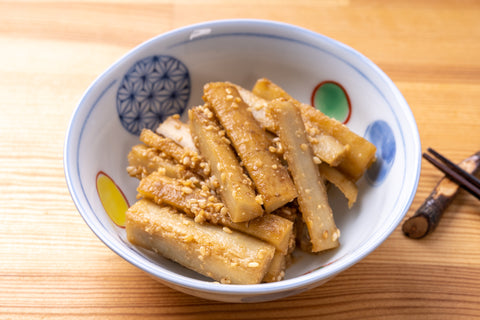
The link between Gobo and New Year food in Japan has already been alluded to in this article and Tataki-Gobo (literally “pounded burdock root”) is a common side dish eaten in the New Year. After simmering the Gobo until parboiled, it is pounded and shredded into smaller pieces. It can then be seasoned with sesame seed paste, dashi, soy sauce, vinegar, and sugar.
Gobo Salad

Crunchy Gobo Salad is a delicious and refreshing dish that you can enjoy the whole year round but it is especially enjoyed as a cold dish in the summer months. Burdock root is braised to a level where it is still crunchy, and the root and carrots are julienned before adding either a creamy mayonnaise sauce or alternatively a sesame and balsamic vinegar sauce.
Other Gobo Dishes
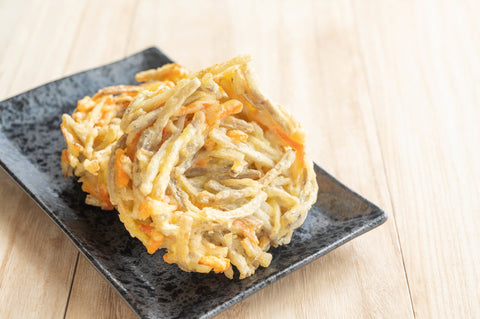
In addition to the above, Gobo is a popular ingredient, when thinly sliced, for Kakiage-Tempura. It is also used in Nimono (literally “simmered dishes”) where Gobo and other root vegetables, as well as meat such as chicken, are simmered in a mix of dashi broth, and flavorings, such as Dashi broth, Shoyu, Sake, Mirin, and Miso, to absorb their flavors. Gobo is also a popular ingredient in Miso Soup, another classic Japanese dish.
Choosing Good Gobo
So, once you have decided to take the plunge and start using Gobo in your cooking, what should you look for when choosing it?
The first thing you should take note of is its thickness. Gobo that is too thick may have a hollow inside. Select a root that is neither too thick nor too thin, but one that has grown evenly throughout its entire length.
It is also important that the whisker-like threads that grow off the root be both small in number and fine in nature. This marks burdock roots that have been raised in a strong soil environment and that are likely to have a stronger flavor.
In the supermarket, you may find Gobo that still has earth attached and other Gobo that has been washed. Although pre-washed Gobo is certainly convenient, Gobo with earth attached will have a stronger fragrance and will be easier to store. Before choosing washed or unwashed, first decide whether your priority is convenience or long-term storage.
Lastly, do the touch test. If the Gobo feels soft or squishy, it is likely that the Gobo is past its best and is no longer fresh.
Preparing Gobo
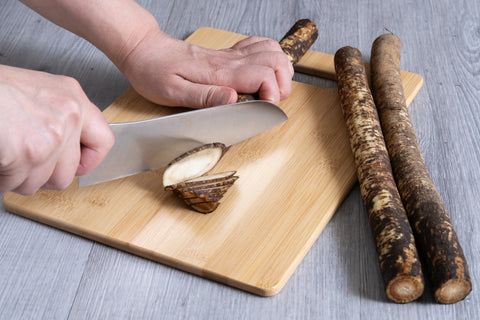
After cleaning off any extraneous earth, you will need to peel the skin. Note, however, that as most of the flavor is between the skin and the root itself, it is important to peel the skin as thinly as possible. A scrubber or vegetable brush should be sufficient when dealing with recently picked, fresh roots. For older roots, scrape with the back of a kitchen knife.
After soaking in water for ten minutes or so remove excess lye, you can cut the gobo into the desired shape. Popular shapes to use in cooking include shaved, julienne, matchsticks, or chunks.
Storing Gobo
Gobo tends to dry out easily, so humidity control is the key to preserving it. It will last longer if kept moist at room temperature or refrigerated. Gobo with the earth still attached can be stored without refrigerating in rooms where the temperature is below 15℃. Alternatively, it can be placed in kitchen paper or newspaper, then put in a plastic bag, and stored in a cool place out of the sun, where it will keep for about one month. Another option for keeping it out of the sun is to bury it in earth.
If you have already cleaned and/or cut the Gobo, wrap the pieces in kitchen paper or newspaper, place them in a plastic bag, and keep them in the vegetable compartment of your refrigerator. You should aim to eat it within about a week, however. It can also be put in a freezer bag and frozen where it will keep for 3-4 weeks.
Purchasing Gobo In All Its Forms
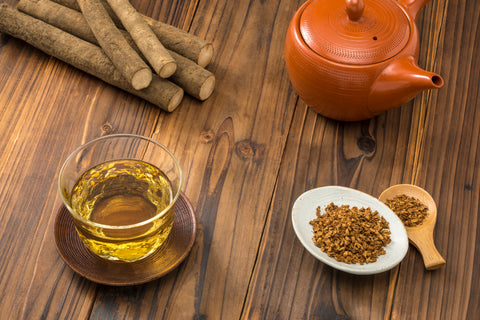
You will not need to look very hard in Japan to purchase Gobo either pre-washed or otherwise, and it can be found in nearly all greengrocer’s, as well as the fresh vegetable section of supermarkets. You can also buy frozen Gobo pieces and Gobo chips in Japanese supermarkets. If you are interested in what Gobo tastes and smells like, and are enticed by the health benefits of Gobo, but are not keen on the idea of including roots in your diet, you might like to try this non-caffeine tea, which still contains all the polyphenols of the root itself, and will also allow you to sample its deep aroma.
Gobo – Healthy, Versatile, And Delicious
Although you may experience some reluctance to eat roots, Gobo is definitely worth getting to know. It has a wide range of health benefits, it can be used in a wide variety of dishes, both cooked and uncooked across all seasons, and many find they really enjoy the flavor and aroma once they get used to it.
Have you tried Gobo yet? If so, in what kind of dishes do you like it the most? Let us know in the comments.


0 comments